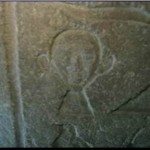By Jide Uwechia

Barack Obama visited the shrine of his forefathers in Egypt June 04, 2009. He got a very personal close up tour of the Pyramids and other ancient sites of ancient Egypt courtesy of the curator of the Egyptian museum Hawis.
Upon getting into one of the tombs, one could not help but notice the very striking resemblance between President Obama and the portrait of the Egyptian dignitary buried in the tomb. The name of the ancient Egyptian dignitary was Kar. One must note here that spelt backwards Barack comes up as “Karab” (omitting the “c” which is just a variation of the spelling convention). “Kar-ab” does sound very close to “Kar” the man buried in the Egyptian tomb. In ancient Khemit “ab” is a word that designates the heart. Kar-ab could then mean “the heart of Kar”. Is Barack the heart of Kar?

Kar lived about 4,600 years ago in ancient Egypt. Kar was a great and devoted Black African (Khemitian) who had served one of the Pharaohs of Egypt. Just like President Barack, Father Kar was a priest, a scholar, a lawyer and an advocate. He later became a great judge.
According to reports and video footages coming out of this visit, the portrait of Kar looked eerily similar to President Barack Obama. The resemblance was so much that he, Obama was the first one to point this out in complete astonishment. Others visiting with him were called over to view the portrait of Kar and without doubt all confirmed the close similarity between this ancient judge and the modern President, including the famous big ears.
Zahi Hawas, the two-faced curator of Egyptian antiquities who constantly down plays the fact that Egypt was a Black African civilization was suddenly falling over his head to confirm the amazing physical resemblance between Obama and the ancient Egyptian dignitaries.
According to Hawas, President Obama looked like King Tut, the same king that Hawas had slyly sought to depict as a pale skin so-called white man barely two years ago. Yet, standing before the Black President and King, Mister Hawas made this recantation: “Mister President, you look like King Tut. It’s true. I said this the whole time – two years ago. You were a king in ancient Egypt.”


I think that these white boys are real fool. in their history books they told us that the first white in Africa where the Portuguese, OK, then they told us that they arrived about 1440 or there about we are still ok with that.
So how could Jesus be white, if there was no white man in Africa before 1440?. The English did not come to Africa till the 15th or 16th hundred, so where did this white man call Jesus come? how is he whites if there were no white man before that date? . And my white friends, this is not Negro facts, these are written in your history books written by you.
India are 100% blacks i am living in India right now, Lord Krishna the Indian God was black, we are not saying nor are we ruling out that he was African.
To all of you who are in any confusion about Africa being the original Egyptians all you have to do is look at the clothing hair style of a nation, and you will know.
The Architecture of the Pyramids is not of Arabic culture, so therefore can’t be Arabic, i go to the Mosque and i see Arabic Architecture, and it is not of the same as the Pyramids. If they were Arabic why is there no Pyramids in the Arab world? but you find Pyramids all over Africa? AND LASTLY there is no people as Negroid, there are no People, place, town ,Country or city in Africa call Negroid , This must be People, or places in Europe. If you where in your European stupidity when you arrived in Niger or Nigeria and could read correctly then we can over stand your Ignorance, of the people of Africa . Please let me enlighten you about Niggers or Negroids. Here are some facts that you may look up
Quorra” redirects here. For the Tron: Legacy character, see Quorra.
This article is about the river. For the play or movie, see The River Niger. The Niger at Koulikoro, Mali
The Niger River ( /?na?d??r/ NY-j?r) is the principal river of western Africa, extending about 4,180 km (2,600 mi). Its drainage basin is 2,117,700 km2 (817,600 sq mi) in area.[3] Its source is in the Guinea Highlands in southeastern Guinea. It runs in a crescent through Mali, Niger, on the border with Benin and then through Nigeria, discharging through a massive delta, known as the Niger Delta or the Oil Rivers, into the Gulf of Guinea in the Atlantic Ocean. The Niger is the third-longest river in Africa, exceeded only by the Nile and the Congo River (also known as the Zaïre River). Its main tributary is the Benue River.
The Niger is called Jeliba or Joliba “great river” in Manding, Orimiri or Orimili “great water” in Igbo, Egerew n-Igerewen “river of rivers” in Tuareg, Isa Ber “big river” in Songhay, and Oya in Yoruba. The origin of the name Niger, which originally applied only to the middle reaches of the river, is uncertain. The likeliest possibility is an alteration, by influence of Latin niger “black”, of the Tuareg name egerew nigerewen, which is used along the middle reaches of the river around Timbuktu.[4][5] As Timbuktu was the southern end of the principal Trans-Saharan trade route to the western Mediterranean, it was the source of most European knowledge of the region.
Medieval European maps applied the name Niger to the middle reaches of the river, in modern Mali, but Quorra (Kworra) to the lower reaches in modern Nigeria, as these were not recognized as being the same river. When European colonial powers began to send ships along the West coast of Africa in the 16th and 17th centuries, the Senegal River was often postulated to be seaward end of the Niger. The Niger Delta, pouring into the Atlantic through mangrove swamps and thousands of distributaries along more than a hundred miles, was thought to be no more than coastal wetlands. It was only with the 18th century visits of Mungo Park, who travelled down the Niger River and visited the great Sahelian empires of his day, that Europeans correctly identified the course of the Niger, and extending the name to its entire course.
The modern nations of Nigeria and Niger take their names from the river, marking contesting national claims by colonial powers of the “Upper”, “Lower” and “Middle” Niger river basin during the Scramble for Africa at the end of the 19th century.